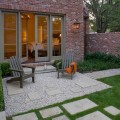Formal Garden Ideas
Formal garden ideas vary extensively from culture to culture and are in many ways derivative of specific periods of history as well. However, all share a common humanism that seeks to place man at the pinnacle of nature, the master of the planet if you will. As such, symmetry and geometry form the foundational elements of all formal garden styles, regardless of type or size.
Geometry is typically based upon key motifs of home architecture. Normally as well, the direction of the garden points to the home in a sense. Some gardens are built along a central axis that lines up with a balcony, a window, or a door. Others have bisecting axes that lead to a central courtyard where a focal point like a fountain or sculpture provides a relaxing view of both the garden and the house from multiple vantage points. Regardless, the whole intention here is to make the garden and the home work together in a synergy of elegance that establishes a feeling of order and system throughout the entire landscape.
Most formal garden ideas use a quadrilateral shape of some sort to define garden borders, although spirals and circles are often used to adorn garden interiors. Depending on size or position, the layout may take the form of a perfect square or a rectangle that follows a linear progression through various subdivided sections of greenery, floral motifs, and special decorations. Pathways that run through the garden can be built of stone, brick, or gravel. Material choice is mostly based upon cultural or historical relevance to the particular design being developed.
In order to make any formal garden idea work from an organic perspective, one must approach vegetation from a very selective and controlled perspective. It is very difficult for do-it-yourself gardeners to successfully create their own formal garden designs because they have been conditioned to believe that more is better when it comes to greenery and flowers. In formal design, however, the exact opposite is the case. To many different plant species borders on creating a mini wilderness in the back yard which looks out of control even when constantly manicured. It becomes a self-defeating maintenance nightmare, and it ruins the effect of the style.
Instead, professional garden designers carefully choose first a style, then a limited number of plant materials, to build use in building the entire design. Instead of having countless plants and flowers that overwhelm the senses, landscaping professionals instead create repeating patterns of geometry the same types few shrubs, trees, hedges, and special flowering plants. By interweaving these zones together in spirals arms, circles, rectangles, or squares, designers can create a near infinite number of forms with only a handful of plants that are easy to maintain.
The best way to develop a formal garden idea is to begin looking at what appeals most to your own sensibilities, then consulting with a professional designer who can help you develop your ideas into an impeccable design that will become the defining keynote of your entire property. Good sources of inspiration include image searches on the Internet, magazines, and gardens of neighbors and friends that suit your fancy.
Always be sure to work with a company like Exterior Worlds that has expert knowledge of botany, drainage, and irrigation techniques. The Houston landscape can be very tricky and problematic when it comes to water management, so it is always best to work with an experienced firm who can not only fully develop your formal garden ideas, but who can also safeguard them against flooding and drought that can come as a result of our often unpredictable weather cycle.

